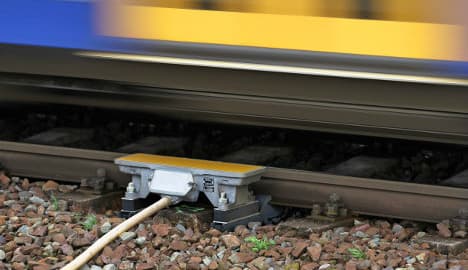Why the Bavarian train crash should never have happened

Over 96 percent of Germany's rail network is fitted with the PZB system, which is supposed to prevent collisions – so how did Tuesday morning's full-frontal crash happen?
Rail operator Deutsche Bahn, which is also responsible for maintenance on the stretch of track where Tuesday's accident occurred, confirmed that it is fitted with PZB.
The PZB system "is supposed to mean that this kind of head-on collision can't happen," Transport Minister Alexander Dobrindt told a press conference on Tuesday afternoon.
"Over the decades, a lot has been invested in technical equipment... I had been almost convinced in recent years that such a thing could never repeat itself," Bavarian interior minister Joachim Herrmann agreed.
The PZB system was rolled out to the entire German rail network following a deadly crash near Magdeburg in January 2011 that killed 10 people.
A Deutsche Bahn spokesman said on Tuesday afternoon that the system had last been checked a week before the crash and no problems were found.
We won't know until investigators have analysed the black boxes from both trains exactly what caused the crash – but attention is now focused on these devices.
How the PZB system works
Under normal conditions, the devices are used to stop trains travelling at up to 160mh/h from ending up heading towards each other on the same line.
The system uses magnets set up on the track bed to communicate with a device on board the train.
Magnets are placed at a pre-signal and again 1,000 metres further on at the main signal. If the main signal is showing a red light, this is also shown on the pre-signal, which will then set off an alarm in the driver's cabin.
Train drivers must press a button within four seconds of the PZB alarm sounding to confirm that they have seen the pre-signal – or else the train is automatically braked by the PZB system.
The same thing happens if a driver rolls through a red main signal.
Automatic braking also kicks in if the driver doesn't stay below the maximum speed on sharp turns.
And there's an even stricter system on lines where trains travel faster than 160km/h.
Speed isn't checked only at signals, but constantly monitored using a system known as LZB. Just like PZB, this system can automatically hit the brakes under conditions that might threaten safety.
SEE ALSO: Bavaria train crash: what we know so far
Comments
See Also
Rail operator Deutsche Bahn, which is also responsible for maintenance on the stretch of track where Tuesday's accident occurred, confirmed that it is fitted with PZB.
The PZB system "is supposed to mean that this kind of head-on collision can't happen," Transport Minister Alexander Dobrindt told a press conference on Tuesday afternoon.
"Over the decades, a lot has been invested in technical equipment... I had been almost convinced in recent years that such a thing could never repeat itself," Bavarian interior minister Joachim Herrmann agreed.
The PZB system was rolled out to the entire German rail network following a deadly crash near Magdeburg in January 2011 that killed 10 people.
A Deutsche Bahn spokesman said on Tuesday afternoon that the system had last been checked a week before the crash and no problems were found.
We won't know until investigators have analysed the black boxes from both trains exactly what caused the crash – but attention is now focused on these devices.
How the PZB system works
Under normal conditions, the devices are used to stop trains travelling at up to 160mh/h from ending up heading towards each other on the same line.
The system uses magnets set up on the track bed to communicate with a device on board the train.
Magnets are placed at a pre-signal and again 1,000 metres further on at the main signal. If the main signal is showing a red light, this is also shown on the pre-signal, which will then set off an alarm in the driver's cabin.
Train drivers must press a button within four seconds of the PZB alarm sounding to confirm that they have seen the pre-signal – or else the train is automatically braked by the PZB system.
The same thing happens if a driver rolls through a red main signal.
Automatic braking also kicks in if the driver doesn't stay below the maximum speed on sharp turns.
And there's an even stricter system on lines where trains travel faster than 160km/h.
Speed isn't checked only at signals, but constantly monitored using a system known as LZB. Just like PZB, this system can automatically hit the brakes under conditions that might threaten safety.
SEE ALSO: Bavaria train crash: what we know so far
Join the conversation in our comments section below. Share your own views and experience and if you have a question or suggestion for our journalists then email us at [email protected].
Please keep comments civil, constructive and on topic – and make sure to read our terms of use before getting involved.
Please log in here to leave a comment.